 |
Flying High With Electric Power!
The Ampeer ON-LINE!
Fly the Future - Fly Electric! |
|---|
Site Table of Contents
| President: | Vice-President: | Secretary-Treasurer: |
| Ken Myers | Richard Utkan | Rick Sawicki |
| 1911 Bradshaw Ct. | 240 Cabinet | 5089 Ledgewood Ct. W. |
| Commerce Twp., MI 48390 | Milford, MI 48381 | Commerce Twp., MI 48382 |
| (248) 669-8124 | (248) 685-1705 | (2480 685-7056 |
 | ||
| Board of Directors: | Board of Directors: | Ampeer Editor |
| David Stacer | Arthur Deane | Ken Myers |
| 16575 Brooklane Blvd. | 21690 Bedford Dr. | 1911 Bradshaw Ct. |
| Northville, MI 48168 | Northville, MI 48167 | Commerce Twp., MI 48390 |
| (248) 924-2324 | (248) 348-2058 | (248) 669-8124 |
| The Next EFO Meeting: Date: Wednesday, April 12 Time: 7:30 p.m.
Place: Ken Myers' house | ||
| New Event and Award Added to the 2017 Mid-America Electric Flies The Foam scratch-builts are having a big welcome at the Mid-Am this year. | Speaking of the Mid-Am Ken shares a couple of old photos from the Mid-Am, held in Saline, MI. |
| The March EFO Meeting Highlights include; Roger Wilfong's 3 indoor models, Hank Wildman's EDF, Ken's "What is wrong with today's construction articles" group project, video of electric flight in the 1980s, the vollrathd IR meter, calculating flight time, and hints for selecting LiPo batteries for a specific task | Upcoming Keith Shaw Birthday Party Electric Fly-in 2017 Contest Director, Dave Grife, provides the details for this upcoming event. |
| Hobbico Returns to the Ultimate Soccer Arenas Joe Hass announces this upcoming event in Pontiac. | Follow-up Information from the February EFO Meeting Ken answers some questions regardign IR meters, heavy duty LiPo batteries, wire gauge and connector choices. |
| The 2017 33rd Annual Mid-America Electric Flies Links to this year's flyer and map | |
Full details for the July 8 and 9, 33rd Mid-America Electric Flies, are on the Mid-Am 2017 flyer. The link is at the end of this issue. Keith and I have added a new event and a new award this year. We want the Mid-Am to become more inclusive. Many builders are now creating airframes out of non-traditional materials including, but not limited to; sheet foam, foam board, cardboard, block foam, foam insulation material, etc. Many of the creations are unique, and there is a lot to be learned from their construction methods. Examples of these types of aircraft can be found in the Foamies (Scratchbuilt) Forum on RC Groups. They have free plans for downloading, as well as precut 'kits'. The FT Sea Duck looks pretty interesting to me. 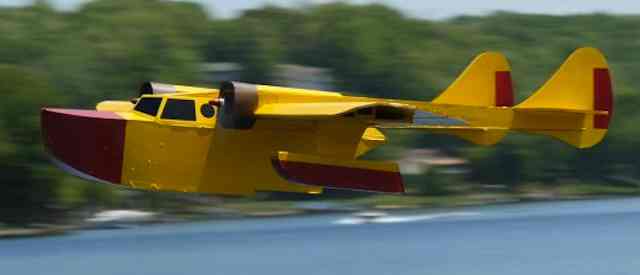
Flite Test Sea Duck
He has free plans for downloading and some precut 'kits' as well. I found the way he created the canopy for his P-39 quite interesting.
He demonstrates and shares, on video, building techniques and other useful information regarding these types of aircraft. Using information garnered from these sources and other sources, along with your own creativity, we hope you'll share your latest creations with us this summer. The NEW Foam Flurry event is a reincarnation of the all up/last down event. The rules are found on the Mid-Am flyer, linked at the end of this issue. Now that should be FUN!!! Speaking of the Mid-Am While in the deep, dark vault of EFO history, I just ran across a couple of photos from an early Mid-Am. The photos were taken sometime in the middle to late 1980s. They are from the meet when it was held at the Saline, MI, flying field of the Ann Arbor Falcons. 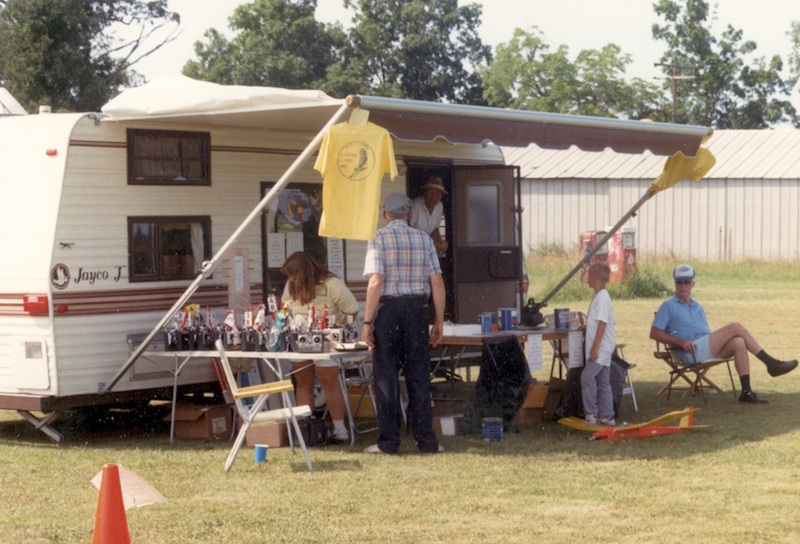 Debbie McNeely can be seen working the transmitter impound, while Ken is exiting the door of his travel trailer. 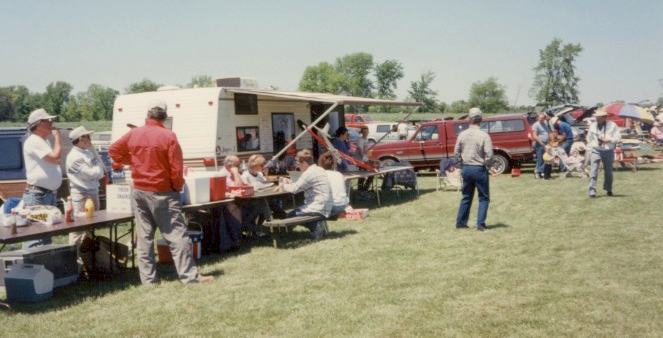 Registration and concessions at an early Mid-Am in Saline, Michigan. The March EFO Meeting The meeting was held on Wednesday, March 8. It was the Day of the Big Wind!!! The wind had blown constantly from about 9 a.m. through 10 p.m. at between 30 mph to 40 mph with gusts frequently reaching 50 mph to 65 mph. There was no storm involved. By the 7:30 meeting time, at Ken's house in Walled Lake, MI, 800,000 residences and businesses were without electric power in the Detroit Metropolitan Area. Trees, power line poles, power cables and phone lines were down all over southeastern Michigan. It was the worst pure wind event we've ever had here since weather records have been kept. Despite the somewhat dangerous driving conditions, due to the high wind and debris on the roads, several folks still managed to attend the monthly meeting and share their latest projects and ideas. Roger Wilfong lead off the meeting by presenting three indoor fliers that he has been working on while recovering from his hip surgery, as well as flying, recently. 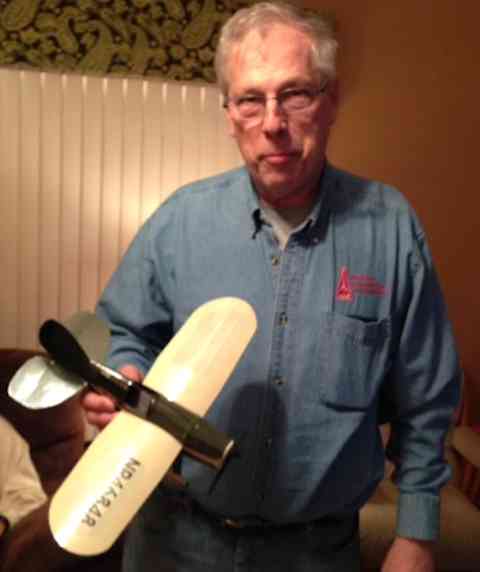 The Mountain Models Art Chester Jeep is built from a kit. It has a wingspan or 16", wing area: 58 sq.in. and a flying weight of about 1.1 oz. It uses a 'brick' type radio system from an indoor ARF. It still needs a bit more finishing, but it is mostly done. 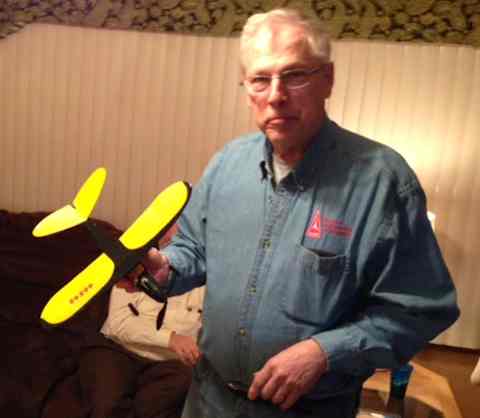 His Flying Models Sweet Patootie was built using plans from the June 2001 issue. The vertical stabilizer is on the fuselage, below the "V" type horizontal stabilizer. Magnets hold on wing. It was originally designed as rubber powered model. It also uses a 'brick' type radio system from an intoor ARF model. He noted that it flies pretty well. He didn't know a lot about his next plane, which he'd purchased at a swap meet. It does say, "DYNEX 2.4 and Air Hobby" on the wing. The foam kit sat at his house, waiting to be built, for quite a long time. 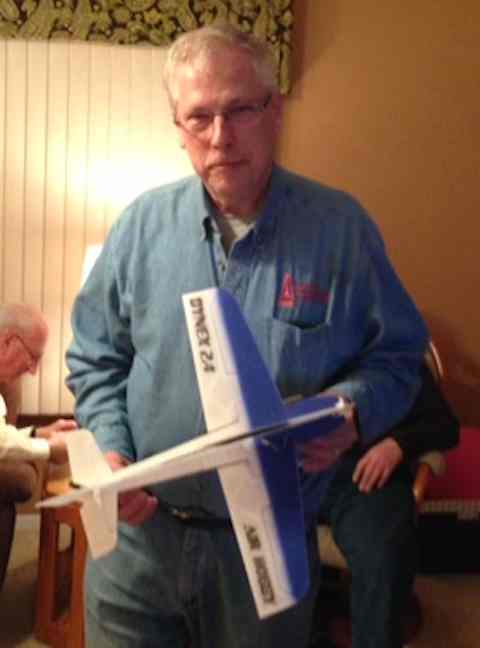 He has a friend that wants to 'transition' to flying with ailerons, so he put this plane together for him. Even though this plane has extremely large ailerons, it flies extremely slowly indoors, and should be a good transition plane for his friend. Roger also noted that, while this planes looks somewhat similar to the UMX Extra 300, the Extra 300 seems to be a lot more fragile. He came to this conclusion because, while not owning one, he's seen a lot of the UMX Extra 300s at the local indoor flying venues. Hank Wildman brought his electric ducted fan (EDF) Twister. He demonstrated the lights and retractable landing gear. He also showed how his Taranis transmitter can 'talk' to him and provide information while flying. 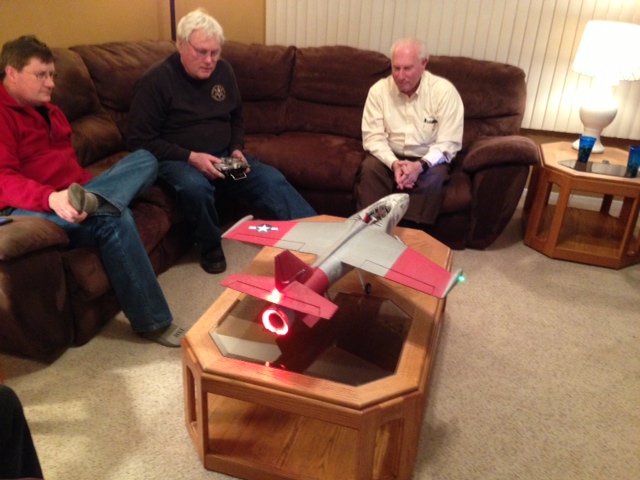 He also shared an oops that happened with his S-bus circuit board from Aloft Hobbies. It happened when he was soldering on some heavy duty leads and accidentally applied the power system's battery pack's full voltage to it instead of a receiver battery. Recently the AMA's publication, Model Aviation, has been trying to encourage more modelers to build their own aircraft. Because of this, Ken Myers had a group activity planned around some construction articles in three recent issues of the magazine. He passed out the issues. Ken had written up several questions for each article, and placed them in each issue. He asked for answers to questions that builders would want to know before building the model. The members, all seasoned aircraft builders, were asked to locate information in the printed construction articles. The questions:
Feb. 2017, Zlin Z-37T, starting on p. 50
March 2017, P-6E Hawk, starting p. 38
This was actually a set up by Ken. All three construction articles did not have the information in the printed article or online where how to order the plans is located. It should be noted that many members actually went online on their phones to see if they could get the information. His whole point was that 'they' sure don't write construction articles like they used to. He showed how he calculated the answers about the Torpedo. He put the .jpg of the plans, found online, into a CAD program, and using the given wing span, he scaled some known line dimensions. He was then able to calculate the wheel diameter, ground clearance and fuselage width. 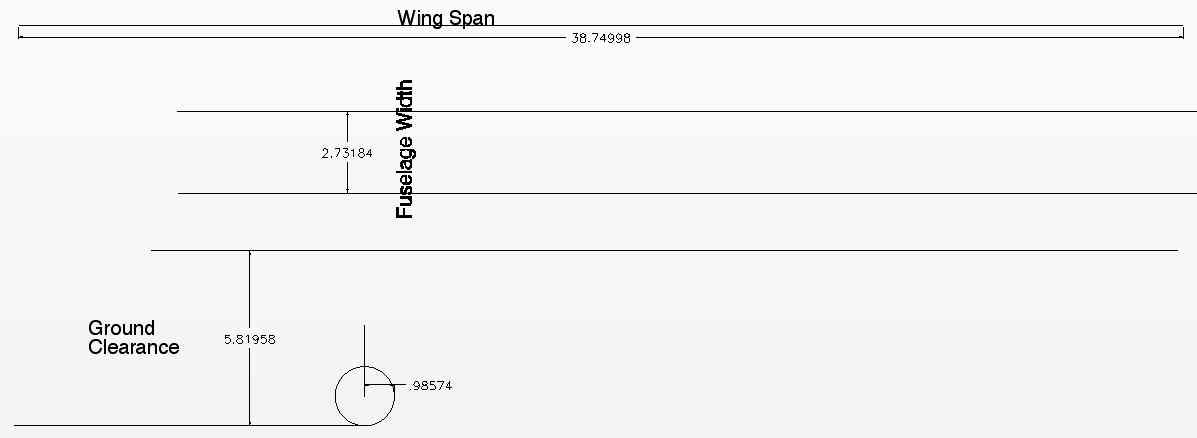 The ground clearance indicated what the largest prop diameter could be and the fuselage width indicated about how wide the landing gear should be. The landing gear width is approximately 2-2/4" and the distance from the center of the prop shaft to the ground is approximately 6". The prop diameter could be 8" with 2" of ground clearance or 9" with 1-1/2" of ground clearance. The ready to fly weight was not given in the article. Only the weight without the battery was stated. He then looked up the weight for the largest battery pack mentioned in the article and found it to be about 100g. That brought the ready to fly weight to 1.25 lb. Once he knew the ready to fly weight he used his spreadsheet from his article "Selecting an Electric Outrunner Motor Power System for an ARF, Kit or Plans Built Electrically Powered or Glow Conversion Prop Plane" to determine an appropriate power system using an APC 9x7.5E prop. 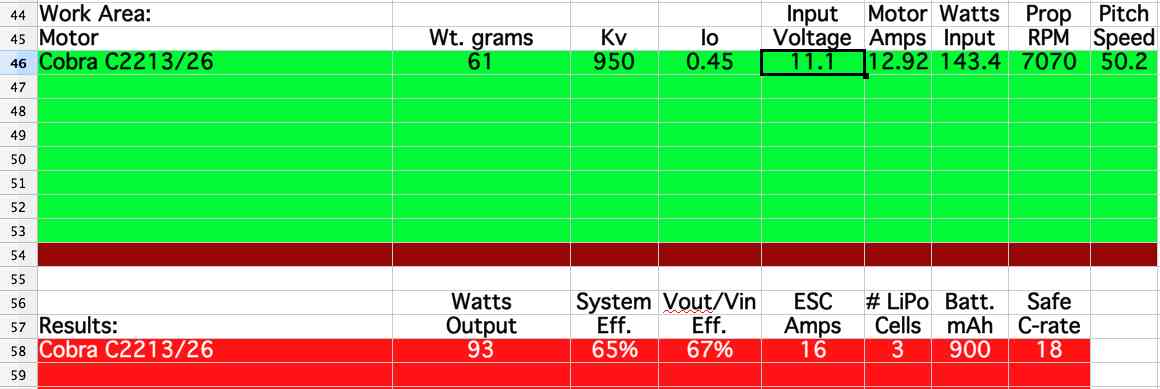 His choice was a Cobra C2213/26 with a 16 amp or greater ESC and a 3S 1000mAh LiPo. Unfortunately, he never could figure out what landing gear to use. While the Zlin looks like a really nice sport scale plane, by an excellent designer and builder, there was just not enough information presented to make any determinations about it. The only thing noted in the article about the power system was that it required a 300-watt brushless outrunner (no prop given) and a 3S 3200mAh LiPo. There was a lot of the required information available for the P-6E. Pat Tritle is famous for his light weight structures. Ken noted that his power system seemed a bit 'odd' though. He ran the system through Drive Calculator. 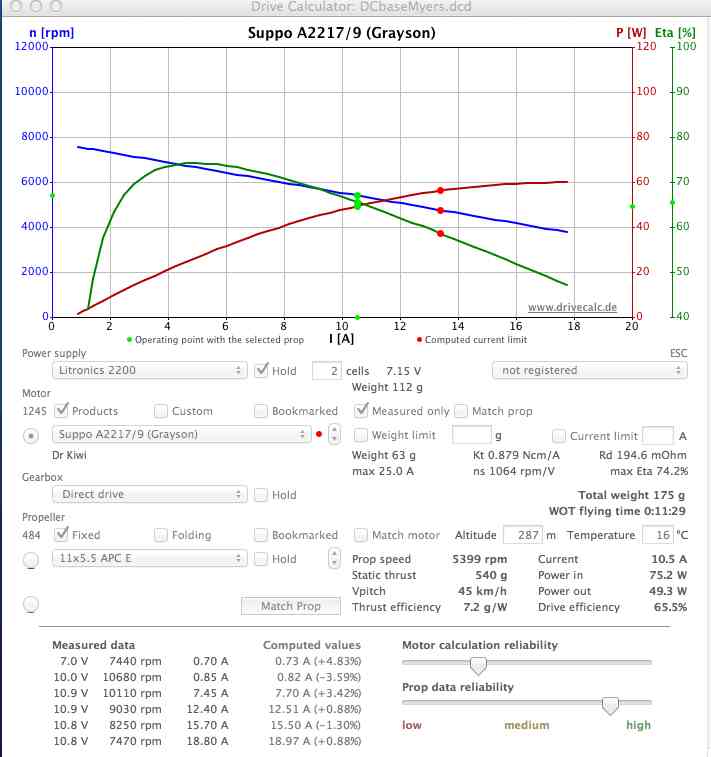 The results were 'interesting'. It showed that the recommended motor pulled about 10.5 amps when turning an APC 11x5.5 (recommended prop) at about 75.2 watts in. The pitch speed, 45km/h is 28 mph. Ken thought that was a bit on the low side for a plane with a WCL of just over 4, which is typical for a backyard flier. 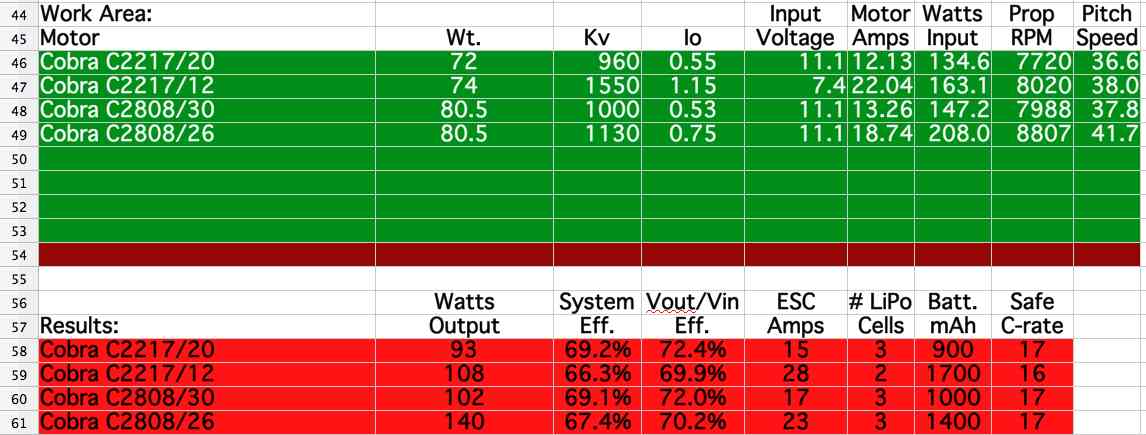 He used his spreadsheet to pick and alternate power system. He said that he would choose a Cobra C2217/20 with a 15 amps or greater ESC and a 3S 1000mAh LiPo. At least there was enough information presented in the article to make some decisions about the plane and its flight characteristics. Ken forgot to mention at the meeting that there was one more item that he found frustrating in a recent ARF kit review in the March 2017 Model Aviation. The review was for the AJ Aircraft Acuity, starting on p. 57. The reviewer repeatedly mentioned the aircraft's light weight of 6.2 pounds. The term light weight is a relative term and there was absolutely nothing in the article to relate a light weight of 6.2 lb. to. The wing area, which is easily used to compare relative weight, was not given, nor anything else to compare it to. Ken realizes that the wing area is not given for the airplane on the supplier's Web site, but the reviewer had the aircraft in-hand. Why wasn't a wing area given? Next Ken played a video on TV while he prepared the refreshments. The video is called, "Electric Flight in the 90s". Ken and Jeff Hauser put the original VHS tape video together near the end of 1989. Those who had not seen the video were a bit amazed at what we were flying, way back then, with brushed motors and NiCads. It was fun to watch Keith watch a bunch of his planes in the early days. What is even more interesting is that the vast majority of Keith's airframes are still flying in 2017! Refreshments were served and everyone had lots of things to discuss. Hank asked about the Hobby King (HK) Graphene series of batteries. Ken responded that they might just be the best batteries he can get for his demanding electric ducted fan (EDF) models. Ken noted that while he had no personal experience with the Graphene series from Hobby King, all the reports heĠd read on RC Groups were extremely positive. The only qualification Ken gave was that, based on recent comments on RC Groups, the quality control might be slipping a little, as some folks seem to be receiving some HK Graphene packs with issues on a cell or two. HK does have 30 warranty. 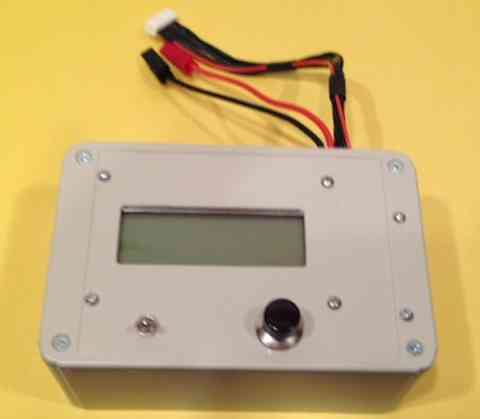
IR meter by vollrathd of RC Groups Hank also wanted to see how the vollrathd IR meter works, and what useful information about the battery it reveals. Ken showed him how the set the capacity of the battery in mAh and then Hank repeated the process. Once the meter was ready for use, they hooked up a Turnigy Nano-Tech 5S 3.3Ah that Hank had brought with him. The meter does a very good job of calculating each cell's internal resistance based on the 2-Tier DC load method. The meter showed about 5.18mOhm (0.00518ohms) on each cell of the pack. Hank asked if that was a 'good' number. Ken reminded him that the internal resistance varies greatly with the temperature of the pack. His pack had come over to the house in his foam EDF Twister and sat on the coffee table for about 90 minutes. How long the pack had heat soaked in the foam airframe in the house was hard to say. They guessed that all of the cells of the pack had reached the ambient temperature of 220C to 230C (71.60F to 73.40F). That is the temperature range to use for 'comparisons'. Ken told Hank that the size (capacity) of the cells has an influence on what is a 'good' internal resistance ohmic value. The following morning, Ken checked the numbers using the LiPo Tool online. The 'tool' suggested that the pack was good to a 'safe' maximum continuous amp draw of 62 amps. The 'tool' also presents a calculated figure of merit (FOM) to use as a basis of comparison to other packs. The figure of merit for this pack was 0.70. For Hank's demanding EDF applications, a pack with a FOM of 1 or greater would be a better choice. Hank told Ken that he had used an AstroFlight Whattmeter and noted that it was pulling about 60 amps at full throttle. He also said that he pretty much flies his EDFs at full throttle for the whole flight. He told Ken that he has his timer set for 4 minutes when flying the Twister. Ken showed him about how to calculate how long his flight time should be using the 3.3Ah (amp-hour) battery in his Twister EDF. Step 1: To keep the pack 'happy' and in good condition, use only 80% of the stated capacity.
The amp-hours (Ah) are changed to amp-minutes. Why? No one ever says, "I flew for 0.1 (one tenth) hours." We say we flew for 6 minutes. Step 2: Multiply 2.64Ah times 60 to get amp minutes
Since Hank noted that he flies at almost full throttle for most of the flight, the maximum amp draw of 60 was used as the average amp draw for the calculation. Step 3: Divide the usable amp-minutes by the average amp draw 158.4 amp-minutes divided by 60 amps = 2.64 minutes.There are 60 seconds in a minute. 60 seconds times 0.64 minutes = 38.4 seconds. His flight time, if he is averaging 60 amps should be 2 minutes and 38 seconds. To keep his battery in good condition, Hank needs to set his timer to about 2 minutes and 30 seconds, not the 4 minutes he had stated. To calculate a better average amp draw, Ken told him to set up his throttle to activate the timer on his transmitter and then note the time when he shut down the motor after landing. Using that time, and the mAh returned to the pack by his charger, he can adjust his flight time accordingly. IF the charger returned 2500mAh to the pack, and the motor was on for 3 minutes (3 minutes divided by 60 minutes in an hour = 0.05 hours) then 2.5Ah (amp-hours) divided by 0.05 hours equals 50 amps, which is the approximate average amp draw. IF he returned only 2000mAh, the average amp draw would be 2Ah divided by 0.05 hours equals an average amp draw of 40 amps. If this happens consistently, he could consider changing his timer. 2.64Ah (usable capacity) divided by 40 amps (the average) = 0.066 hours or 3.96 minutes. Setting the timer to 3 minutes and 50 seconds, instead of 3 could be appropriate to still keep the pack 'happy'. Ken also said that he has found that for his sport and sport scale propeller driven models, he has found that his average amp draw is approximately 1/2 of his highest measured static amp draw for the power system with a freshly charged pack. The actually average amp draw depends on the model, the type of flying, wind conditions, ambient temperature and the pilot's skill at throttle management. It was quite a night. Upcoming Keith Shaw Birthday Party Electric Fly-in 2017
The Balsa Butchers are hosting the "Keith Shaw Birthday Party Electric Fly-In", for the 16th year, at their field near Coldwater, MI. The event takes place on Saturday, June 3, 2017. It is a one day event again this year. The event consists of Open Electric Flying with a "Special Guest of Honor Theme". Enjoy a day with the "Pioneering Master of Electric R/C Flight". 8 am - 5 pm Saturday, $15 landing fee. For additional information contact;
The field will be open for guests to fly on Sunday as well. 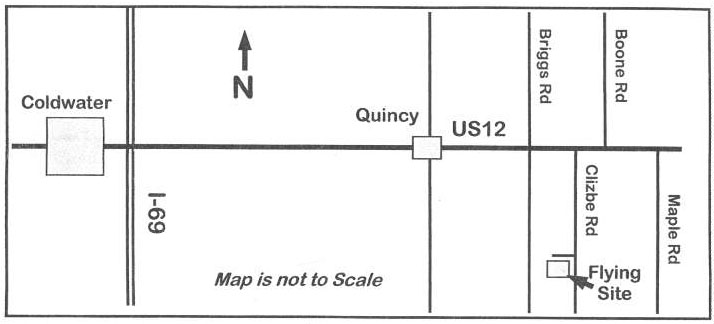 Directions: Quincy is approximately 4.5 miles east of I-69. Clizbe Road is approximately 1.6 miles east of Quincy. The Flying site is approximately 1.5 miles south of US-12 on the west side of Clizbe Road. Hobbico Returns to the Ultimate Soccer Arenas
On Monday, April 3, Hobbico will do its Pre Toledo Show visit at the Ultimate Soccer Arenas from 7 p.m. - 9 p.m. There is no admission and everyone is welcome. On April 4, during the indoor flying from 10 a.m. to 2 p.m., they will do demonstrations. There is no cost if you are not flying. Regular session costs apply to fly. The program will take place upstairs on the mezzanine of Ultimate Soccer Arenas near Field 2 and the bar. We will be using Field 2 for product demos! Follow-up Information from the February EFO Meeting
There were several things that needed clarifying from the February meeting, reported on last month in the March Ampeer. The following is an email that I sent to EFO member, Hank Wildman. Hi Hank, I wanted to go over and clarify some things that we talked about at the February meeting. First, the reason for the big difference in the predicted maximum continuous current between the Wayne Giles ESR meter, the smaller unit, and the BattIR meter, the big, gray one, was because I forgot to set the battery capacity on the BattIR meter. It did its internal 'math' using 2.6Ah (2600mAh), which is what I had it set for, instead of 3.3Ah, which is what your packs were. I recalculated the BattIR prediction using 3.3Ah and it came out to 65 for the maximum continuous amps for the BattIR meter, compared to the ESR meter's 76 amps. Jim talked with you about wire gauge. On your EDFs, drawing high currents, you should be using 10 gauge AWG wire. It looked like that 6S pack had 12 gauge AWG on it. As the AWG number gets smaller, the wire diameter gets larger. This allows more current to pass though it with less resistance. You asked about batteries you could use in those EDFs, as yours do not last. I noticed that you purchase from Hobby King. If their Graphene batteries will fit in your plane(s), be sure to note the dimension specs on the Web site, then they could work for you. Turnigy Graphene 3000mAh 6S 65C Lipo Pack w/XT90 is an example. I cannot find the wire gauge on the HK Web site, but they do have XT-90 connectors on them. XT-90 connectors would be a better choice for your high current EDF applications, compared to the Deans you are now using. I also mentioned that I have had the best luck, in my sport models, using Revolectrix RevoBlends packs. The Revolectrix 3300mAh 6S LiPO - 70C Silver Label GOPACKS - GrapheneOxide Edition would be a good choice Revo for you. Again, be sure to check the dimensions to see that they will fit in your plane. I could not find the AWG gauge listed for the RevoBlends either. Hobby King sells XT-90 connectors, so you could get them from them, if you go with the HK Graphene. If you go with the Revo pack, you can get either XT-90 or EC5 connectors from Progressive RC. EC5 would be my recommendation. Progressive also sells silicone 10 AWG wire. The big, gray internal resistance meter that you asked about building can be found here The individual parts for the unit run about $94. They take approximately two hours to assemble, if you know what you are doing, and to load the program on the PIC. Dave has been working on, improving the code and being able to compile and load the program using a different PIC programmer than the one used by vollrathd or RC Groups. The 2017 33rd Annual Mid-America Electric Flies This year's event takes place on July 8 & 9. The flyer has all the information about the event, and the map and hotel list contains information of the location of the event an area hotels. To Reach Ken Myers, you can land mail to the address at the top of the page. My E-mail address is: KMyersEFO@theampeer.org |